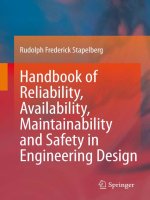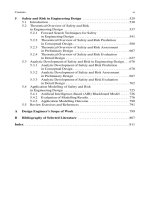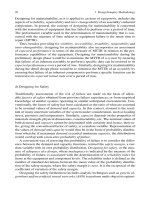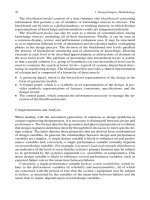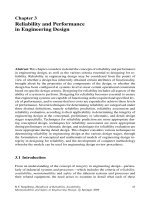Handbook of Reliability, Availability, Maintainability and Safety in Engineering Design - Part 77 potx
Bạn đang xem bản rút gọn của tài liệu. Xem và tải ngay bản đầy đủ của tài liệu tại đây (573.99 KB, 10 trang )
744 5 Safety and Risk i n Engineering Design
Fig. 5.97 Petri net-based optimisation algorithms in system simulation
dynamic modelling, time series prediction, adaptive control, etc., of various engi-
neering design problems. A typical design problem that is ideal for ANN mod-
elling is the formulation and evaluation of stream surge p ressures in continuous
flow processes, given in the simulation option of the AIB blackboard as illustrated
in Fig. 5.97.
The NeuralExpert
c
(NeuroDimension 2001) program, imbedded in the AIB
blackboard, asks specific questions and intelligently builds an ANN. The first step in
building an ANN is the specification of the problem type, as illustrated in Fig. 5.102.
The four currently available problem types in the NeuralExpert are classification,
function approximation,prediction, and clustering. Once a problem type is selected,
the program configures the parameters based on a description of the problem. These
settings can be modified in the AIB blackboard, or in the NeuralExpert.
Input data selection is the next step in constructing an ANN model. The input
file selection panel specifies where the input data file is located by choosing the
‘browse’ button and searching through the standard Windows tree structure to find
the relevant file referenced in the AIB blackboard database, or by clicking on the
triangle at the right edge of the text box to indicate a list of recently used text files
in th e NeuralExpert.
5.4 Application Modelling of Safety and Risk in Engineering Design 745
Fig. 5.98 AIB blackboard model with CAD data browser option
Figure 5.103 illustrates typical input data attributes for the example used to de-
termine the stream surge pressure given in the simulation model option of the AIB
blackboard illustrated in Fig. 5 .97. In this case, the sample data would represent
x
1
, x
2
, x
3
, x
4
values of the input attributes. The pressure surge Petri net given in
Fig. 5.97 includes conditions of flow surge criteria that now become the ANN input
attributes, such as the pipe outlet diameter, pipe wall thickness, the fluid bulk mod-
ulus, and Young’s modulus. The goal is to train the ANN to determine the stream
surge pressure (desired output) based on these attributes.
Typical computational problems associated with artificial neural network pro-
grams, with regard to specific as well as general engineering d esign requirements,
include the following:
Classification problems are those where the goal is to label each input with
a specified classification. A simple example of a classification problem is to la-
bel process flows as ‘fluids’ and/or ‘solids’ for balancing (the two classes, also the
desired output) using their volume, mass and viscosity (the input). The input can be
either numeric or symbolic but the output is symbolic in nature. For example, the
desired output in the process balancing problem is the ratio of fluids and solids, and
not necessarily a numeric value of each.
746 5 Safety and Risk in Engineering Design
Fig. 5.99 Three-dimensional C AD integrated model for process information
Function approximation problems are those where the goal is to determine a nu-
meric value, given a set of inputs. This is similar to classification problems, except
that the output is numeric. An example is to determine the stream surge pressure
(desired output) in numeric values, given the pipe outlet diameter, the pipe wall
thickness, the fluid bulk modulus and Young’s modulus. These problems are called
function approximation because the ANN will try to approximate the functional re-
lationship between the input and desired output. Prediction problems are also func-
tion approximation problems, except that they use temporal information (e.g. the
past history of the input data) to make predictions of the available data.
Prediction problems are those where the goal is to determine an output, given
a set of inputs and the past history of the inputs. The main difference between pre-
diction problems and the others is that prediction problems use the current input
and previous inputs (the temporal history of the input) to determine either the cur-
rent value of the output or a future value of a signal. A typical example is to predict
process pump operating performance (desired output) from motor current and de-
livery pressure performance values.
Clustering problems nformation is to be extracted from input data without any
desired output. For example, in the analysis of process faults in designing for safety,
the faults can be clustered according to the severity of hazard consequences risk.
5.4 Application Modelling of Safety and Risk in Engineering Design 747
Fig. 5.100 CAD integrated models for process information
The fundamental difference between the clustering problem and the others is that
there is no desired output (therefore, there is no error and the ANN model cannot be
trained using back propagation).
For classification problems to label each input with a specified classification, the
option is given to randomise the order of the data before presenting these to the
network. Neural networks train better if the presentation of the data is not ordered.
For example, if the design problemrequires classifying between two classes, ‘fluids’
and/or ‘solids’, for balancing these two classes (as well as the desired output) using
their volume, mass and viscosity (the input), the network will train much better if
the fluids and solids data are intermixed. If the data are highly ordered, they should
be randomised before training the artificial neural network.
One o f the primary goals in training neural networks in the process of ‘iterative
prediction’ is to ensure that the network performs well on data that it has not been
trained on (called ‘generalisation’). The standard method of ensuring good general-
isation is to divide the training data into multiple datasets or samples, as indicated in
Fig. 5.104. The most common d atasets are the training, cross validation, and testing
datasets.
The cross validation dataset is used by the network during training. Periodi-
cally while training on the training dataset, the network is tested for per formance
748 5 Safety and Risk in Engineering Design
Fig. 5.101 ANN computation option in the AIB blackboard
on the cross validation set. During this testing, the weights are not trained but the
performance of the network on the cross validation set is saved and compared to
past values. The network shows signs of becoming over-trained on the training data
when the cross validation performance begins to degrade. Thus, the cross validation
dataset is used to d etermine when the network has been trained as best as possible,
without over-training (i.e. maximum generalisation).
Although the network is not trained with the cross validation set, it u ses the cross
validation set to choose the best set of weights. Therefore, it is not truly an out-
of-sample test of the network. For a true test of the performance of the network, an
independent (i.e. out of sample) testing set is used. This provides a true indication of
how the network will perform on new data. The ‘out of sample testing’ panel shown
in Fig. 5.105 is used to specify the amount of data to set aside for the testing set.
It is important to find a minimal network with a minimum number of free weights
that can still learn the prob lem. The minimal network is more likely to generalise
well with new data. Therefore,once a successful training session has been achieved,
the process of decreasing the size of the network should commence, and the training
repeated until it no longer learns the problem effectively.
The genetic optimisation component shown in Fig. 5.106 implements a genetic
algorithm to optimise one or more parameters within the neural network. The most
common network parameters to optimise are the input columns, the number of
5.4 Application Modelling of Safety and Risk in Engineering Design 749
Fig. 5.102 ANN NeuralExpert problem selection
hidden processing elements (PEs), the number of memory taps, and the learning
rates. Genetic algorithms combine selection, crossover a nd mutation operators with
the goal of finding the best solution to a problem. Genetic algorithms are general-
purpose search algorithms that search for an optimal solution until a specified ter-
mination cr iterion is met.
Network complexity is determined by the size of the neural network in terms of
hidden layers and processing elements (neurons). In general, smaller neural net-
works are preferable over large ones. If a small one can solve the problem suffi-
ciently, then a large one will not only require more training and testing time but also
may perform worse on new data. This is the generalisation problem—the larger the
neural network, the more free parameters it has to solve the problem. Excessive free
parameters may cause the network to over-specialise or to memorise the training
data. When this happens, the performance of the training data will be much better
than the performance of the cross validation or testing datasets.
The network complexity panel shown in Fig. 5.107 is used to specify the size of
the neural network. It is essential to start ANN analysis with a ‘low-complexity’ net-
work, after which analysis can progress to a medium-or high-complexitynetwork to
determine if the performance results are significantly better. A disadvantage is that
medium- or high-complexity networks generally require a large amount of data.
750 5 Safety and Risk in Engineering Design
Fig. 5.103 ANN NeuralExpert example input data attributes
In the NeuralExpert
c
(NeuroDimension 2001) program, imbedded in the AIB
blackboard, several criteria can be used to evaluate the fitness of each potential so-
lution. The solution to a problem is called a chromosome. A chromosome is made
up of a collection of genes, which are simply the neural network parameters to be
optimised. A genetic algorithm creates an initial population (a collection of chro-
mosomes) and then evaluates this population by training a neural network for each
chromosome. It then evolves the population through multiple generations in the
search for the best network parameters. Performance measures of the error crite-
rion component provide several values that can be used to measure the performance
results of the network f or a par ticular dataset. These are:
• the mean squared error (MSE),
• the normalised mean squared error (NMSE),
• the percent error (% error).
The mean squared error (MSE) is defined by the following formula
MSE =
∑
P
j= 0
∑
N
i=0
(d
ij
−y
ij
)
2
NP
(5.115)
5.4 Application Modelling of Safety and Risk in Engineering Design 751
Fig. 5.104 ANN NeuralExpert sampling and prediction
where:
P = number o f output processing elements
N = number of exemplars in the dataset
y
ij
= network output for exemplar i at processing elements j
d
ij
= desired output for exemplar i at processing elements j.
The normalised mean squared error (NMSE) is defined by
NMSE =
P·N ·MSE
P
∑
j= 0
N
∑
N
i=0
d
2
ij
−
∑
N
i=0
d
ij
2
N
(5.116)
where:
P = number o f output processing elements
N = number of exemplars in the dataset
MSE = mean squared error
d
ij
= desired output for exemplar i at processing elements j.
752 5 Safety and Risk in Engineering Design
Fig. 5.105 ANN NeuralExpert sampling and testing
The percent error (%E) is defined by the following formula
%E =
100
NP
P
∑
j= 0
N
∑
i=0
|d
ij
−dd
ij
|
dd
ij
(5.117)
where:
P = number o f output processing elements
N = number of exemplars in the dataset
d
ij
= denormalised network output for exemplar i at elements j
dd
ij
= denormalised desired output for exemplar i at elements j.
Knowledge-based expert systems Expert knowledgeof how to solve complex en-
gineering design problems is not often available. Knowledge-based expert systems
are programs that capture that knowledge and allow its dissemination in the form of
structured questions, to be able to determine the reasoning behind a p articular de-
sign problem’s solution. The knowledge-based expert systems incorporated in the
AIB blackboardare based on the classical approach to expert systems methodology,
which incorporates the following:
5.4 Application Modelling of Safety and Risk in Engineering Design 753
Fig. 5.106 ANN NeuralExpert genetic optimisation
• User interface,
• Working memory,
• Inference engine,
• Facts list,
• Agenda,
• Knowledge base,
• Knowledge acquisition facility.
The user interface is a mechanism by which the user and the expert system com-
municate. The working memory consists of a global database of facts used by rules.
The inference engine controls the overall execution of queries or selections related
to problems and their solutions based around the rules. The facts list contains the
data o n which in ferences are derived. An agenda is a list of rules with priorities
created by the inference engine, the patterns of which are satisfied by facts in the
working memory. The knowledge base contains all the knowledge and rules. The
knowledge acquisition facility is an automatic way for the user to enter or modify
knowledge in the system, rather than by having all the knowledge explicitly coded
at the onset of the expert systems design.
The user interface of the AIB blackboard is an object-oriented application in
which the designer can point-and-click at digitised graphic process flow diagr ams

